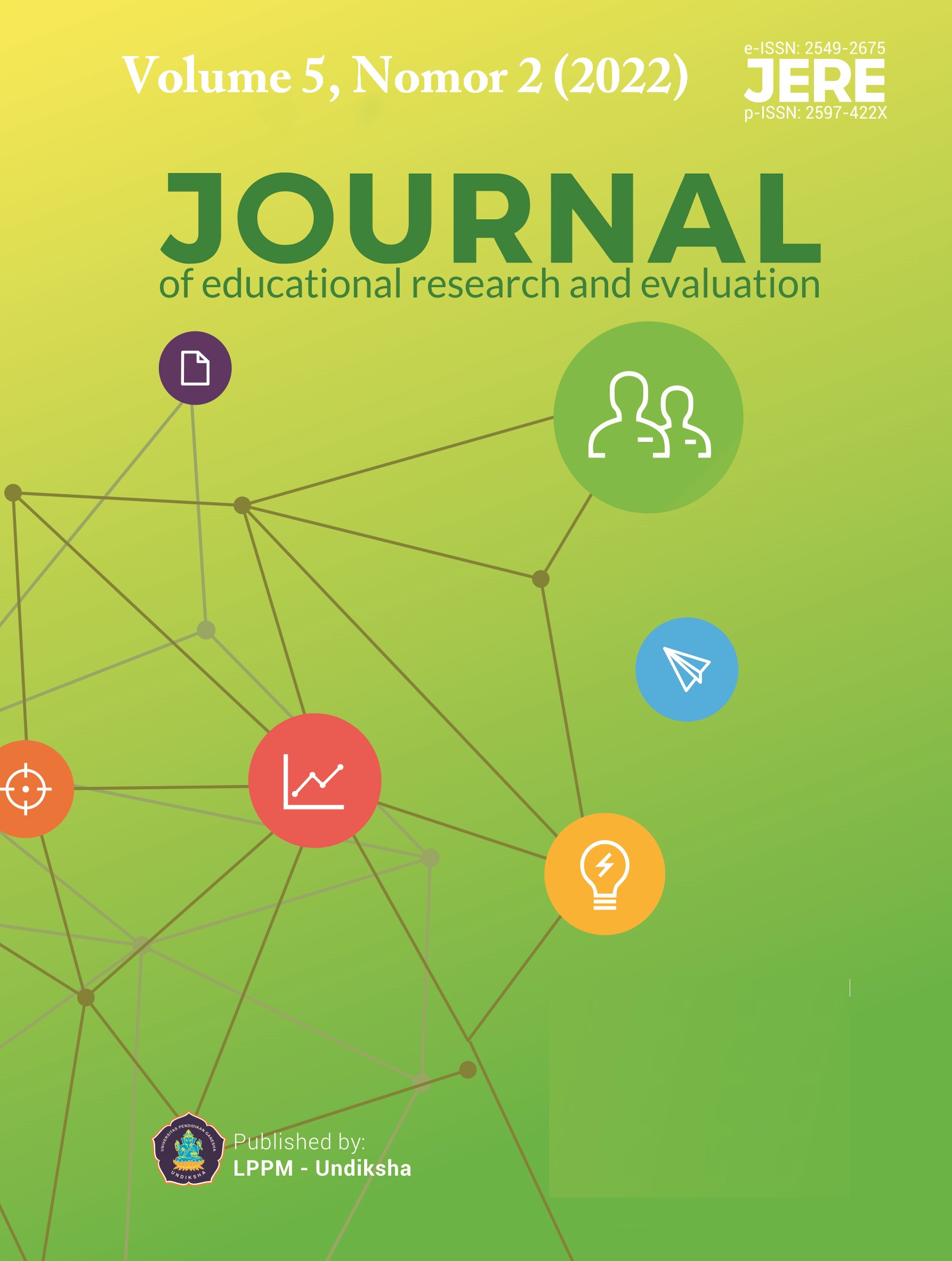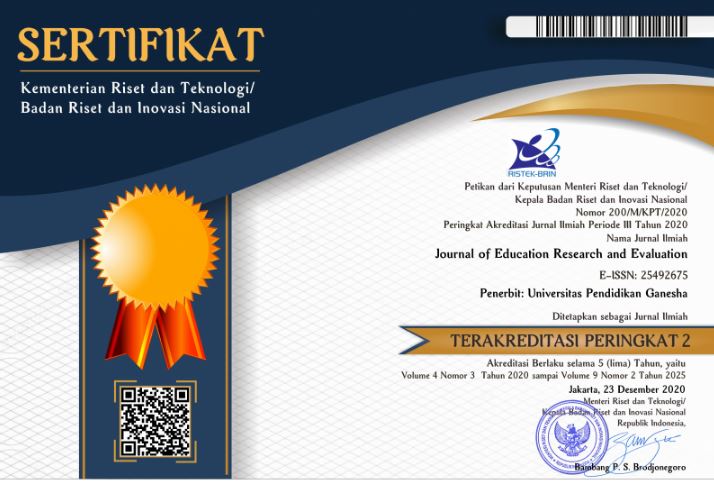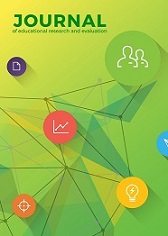Need Analysis of Virtual Laboratory for Vocational School Learning Practices During Covid-19 Pandemic
DOI:
https://doi.org/10.23887/jere.v5i2.32293Keywords:
Distance Learning, Virtual Laboratory, Vocational SchoolAbstract
During the COVID-19 pandemic, schools did not open face-to-face learning services. The Ministry of Education and Culture has issued a policy learning from Home (BDR) to support the principles of the Education Policy in the COVID-19 Pandemic that the health and safety of students, educators, education personnel, families, and the community is the top priority. However, learning in Vocational School (SMK) is mostly based on practice so that BDR activities cannot be implemented. One thing that is done to overcome this is that some practicum activities can be executed using multimedia known as virtual laboratories. This study aims to conduct a need analysis for the development of a virtual laboratory for vocational school learning practices in the Covid-19 Pandemic. The development of this virtual laboratory is based on a product-oriented learning development approach and uses a model development of William W. Lee and Diana L. Owens. The needs analysis stage consists of a needs assessment and a front-end analysis. Needs analysis is carried out to gather data about gaps and needs as well profiles of students that can be used as a basis or reference in developing virtual laboratory at the next stage. Data collection was carried out by means of observation, interviews, and distributing questionnaires. The results showed that a virtual laboratory was needed to support practical learning for vocational students. During the Covid-19 pandemic, this virtual laboratory could be used to help students prepare themselves before entering the real laboratory.
References
Abidah, A., Hidaayatullaah, H., Simamora, R., Fehabutar, D., & Mutakinati, L. (2020). The Impact of Covid-19 to Indonesian Education and Its Relation to the Philosophy of “Merdeka Belajar.” Studies in Philosophy of Science and Education, 1(1), 38–49. https://doi.org/10.46627/sipose.v1i1.9.
Aljuhani, K., Sonbul, M., Althabiti, M., & Meccawy, M. (2018). Creating a Virtual Science Lab (VSL): the adoption of virtual labs in Saudi schools. Smart Learning Environments, 5(1). https://doi.org/10.1186/s40561-018-0067-9.
Alkhaldi, T., Pranata, I., & Athauda, R. I. (2016). A review of contemporary virtual and remote laboratory implementations: observations and findings. Journal of Computers in Education, 3(3), 329–351. https://doi.org/10.1007/s40692-016-0068-z.
Amelia, T., Razak, A., & Rusdinal. (2018). Pengembangan Media Virtual Laboratory Pada Materi Bioteknologi untuk Siswa Kelas XII SMA. ResearchGate, August.
Astuti, I. Y., & Harun, H. (2020). Tantangan Guru dan Orang Tua dalam Kegiatan Belajar Dari Rumah Anak Usia Dini pada Masa Pandemi Covid-19. Jurnal Obsesi: Jurnal Pendidikan Anak Usia Dini, 5(2), 1454–1463. https://doi.org/10.31004/obsesi.v5i2.808.
Bortnik, B., Stozhko, N., Pervukhina, I., Tchernysheva, A., & Belysheva, G. (2017). Effect of virtual analytical chemistry laboratory on enhancing student research skills and practices. Research in Learning Technology, 25. https://doi.org/10.25304/rlt.v25.1968.
Brinson, J. R. (2015). Learning outcome achievement in non-traditional (virtual and remote) versus traditional (hands-on) laboratories: A review of the empirical research. Computers and Education, 87, 218–237. https://doi.org/10.1016/j.compedu.2015.07.003.
Dyrberg, N. R., Treusch, A. H., & Wiegand, C. (2017). Virtual laboratories in science education: students’ motivation and experiences in two tertiary biology courses. Journal of Biological Education, 51(4), 358–374. https://doi.org/10.1080/00219266.2016.1257498.
Fernández-avilés, D., Dotor, D., Contreras, D., & Salazar, J. C. (2016). Virtual labs: a new tool in the Education. 13th International Conference on Remote Engineering and Virtual Instrumentation (REV), February, 271–272. https://ieeexplore.ieee.org/abstract/document/7444480.
Hartini, N., Erlia, & Iqbal, M. (2019). Pengembangan Virtual Laboratory pada topik kultur jaringan tumbuhan untuk meningkatkan hasil belajar siswa. JIPVA (Jurnal Pendidikan IPA Veteran), 3(1), 1–16. https://doi.org/10.31331/jipva.v3i1.658.
Heinich, R., Molenda, M., Russell, J. D., & Smaldino, S. E. (2002). Instructional Media and Technologies for Learning. Merrill Prentice Hall.
Jaya, H., Haryoko, S., & Dirawan, G. D. (2016). Effectiveness the use of Virtual Laboratories in Improving Vocational Competence and Character Behavior for Students Vocational High School in Makassar. International Journal of Applied Engineering Research, 11(9), 6396–6401.
Kurniasari, A., Pribowo, F. S. P., & Putra, D. A. (2020). Analisis efektivitas pelaksanaan belajar dari rumah (BDR) selama pandemi Covid-19. Jurnal Review Pendidikan Dasar: Jurnal Kajian Pendidikan Dan Hasil Penelitian, 6(3), 246–253. https://doi.org/10.26740/jrpd.v6n3.p246-253.
Liu, D., Valdiviezo-díaz, P., Riofrio, G., & Sun, Y. (2015). Integration of Virtual Labs into Science E-learning. Procedia - Procedia Computer Science, 75(Vare), 95–102. https://doi.org/10.1016/j.procs.2015.12.224.
Makransky, G., Mayer, R. E., Veitch, N., Hood, M., Christensen, K. B., & Gadegaard, H. (2019). Equivalence of using a desktop virtual reality science simulation at home and in class. PLoS ONE, 14(4), 1–15. https://doi.org/10.1371/journal.pone.0214944.
Martín-Gutiérrez, J., Mora, C. E., Añorbe-Díaz, B., & González-Marrero, A. (2017). Virtual technologies trends in education. Eurasia Journal of Mathematics, Science and Technology Education, 13(2), 469–486. https://doi.org/10.12973/eurasia.2017.00626a.
Nolen, S. B., & Koretsky, M. D. (2018). Affordances of Virtual and Physical Laboratory Projects for Instructional Design: Impacts on Student Engagement. IEEE Transactions on Education, 61(3), 226–233. https://doi.org/10.1109/TE.2018.2791445.
Potkonjak, V., Gardner, M., Callaghan, V., Mattila, P., Guetl, C., Petrović, V. M., & Jovanović, K. (2016). Virtual laboratories for education in science, technology, and engineering: A review. Computers and Education, 95, 309–327. https://doi.org/10.1016/j.compedu.2016.02.002.
Rowe, R. J., Koban, L., Davidoff, A. J., Thompson, K. H., & Rowe, R. J. (2017). Efficacy of Online Laboratory Science Courses. Journal of Formative Design in Learning. https://doi.org/10.1007/s41686-017-0014-0.
Setiawan, H., Isnaeni, W., Budijantoro, F. P. M. H., & Marianti, A. (2015). Implementation Of Digital Learning Using Interactive Multimedia In Excretory System With Virtual Laboratory. Research and Evaluation in Education Journal, 1(2), 212–224. https://doi.org/10.21831/reid.v1i2.6501.
Sugiyono. (2012). Metode Penelitian Pendidikan (Pendekatan Kuantitatif, Kualitatif dan R&D. Alfabeta.
Yuzulia, I. (2021). The Challenges Of Online Learning During Pandemic : Students ’ V oice. Jurnal Bahasa Dan Sastra, 13(1), 8–12. https://doi.org/10.31294/w.v13i1.9759.
Downloads
Published
How to Cite
Issue
Section
License
Authors who publish with the Journal of Evaluation and Research in Education (JERE) agree to the following terms:
- Authors retain copyright and grant the journal the right of first publication with the work simultaneously licensed under a Creative Commons Attribution License (CC BY-SA 4.0) that allows others to share the work with an acknowledgment of the work's authorship and initial publication in this journal.
- Authors are able to enter into separate, additional contractual arrangements for the non-exclusive distribution of the journal's published version of the work (e.g., post it to an institutional repository or publish it in a book), with an acknowledgment of its initial publication in this journal.
- Authors are permitted and encouraged to post their work online (e.g., in institutional repositories or on their website) prior to and during the submission process, as it can lead to productive exchanges, as well as earlier and greater citation of published work. (See The Effect of Open Access)











